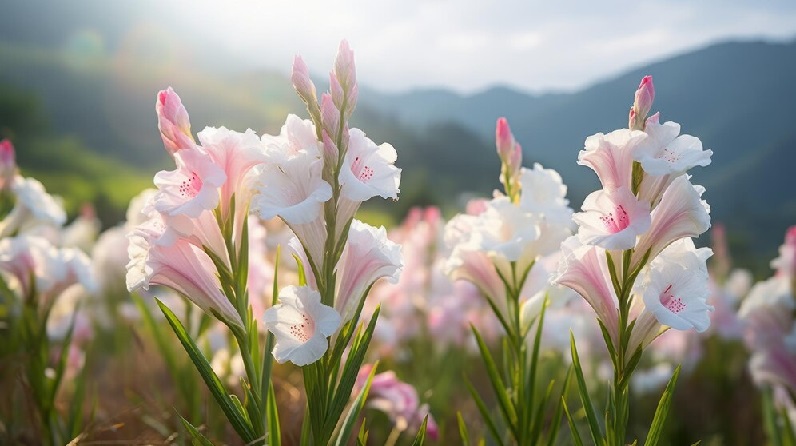The pink lily of the valley, also known as Convallaria majalis var. rosea, is a delightful and rare variety of the traditional white lily of the valley. This charming plant captivates gardeners and flower enthusiasts with its delicate pink blossoms and sweet fragrance. In this article, we will explore the fascinating world of the pink lily of the valley, covering its origins, cultivation, care, and uses.
Origins and History of the Pink Lily of the Valley
The pink lily of the valley is a variant of the classic lily of the valley, which has been cherished for centuries for its beauty and fragrance. Native to Europe and parts of Asia, the lily of the valley has a rich history in folklore and symbolism. The pink variety, while less common, has become a sought-after addition to gardens for its unique color and charm.
Botanical Characteristics
Appearance
The pink lily of the valley is a herbaceous perennial that typically grows to a height of 6 to 12 inches. It features broad, lance-shaped leaves that form a lush green base. The plant’s most striking feature is its arching stems adorned with small, bell-shaped flowers in a delicate shade of pink. These flowers usually bloom in late spring to early summer, adding a touch of elegance to any garden.
Fragrance
One of the key attractions of the pink lily of the valley is its delightful fragrance. The flowers emit a sweet, intoxicating scent that is both nostalgic and refreshing, making it a popular choice for bouquets and perfumes.
Cultivation of Pink Lily of the Valley
Soil Requirements
The pink lily of the valley thrives in well-drained, fertile soil. It prefers a slightly acidic to neutral pH range (6.0 to 7.0). Amending the soil with organic matter, such as compost or well-rotted manure, can enhance its growth and blooming potential.
Light Conditions
While the pink lily of the valley can tolerate a range of light conditions, it performs best in partial to full shade. Too much direct sunlight can scorch the leaves and reduce flowering. Planting it in dappled shade, such as under deciduous trees or along shaded garden paths, provides an ideal environment.
Watering
Consistent moisture is crucial for the pink lily of the valley. It prefers evenly moist soil but does not tolerate waterlogging. Regular watering, especially during dry spells, ensures healthy growth. Mulching around the base of the plant helps retain soil moisture and suppress weeds.
Planting and Propagation
Pink lily of the valley can be propagated by division or by planting pips (small rhizomes). The best time to divide and transplant is in the early spring or fall. To plant, dig a hole deep enough to accommodate the roots, place the pip or divided section in the hole, and cover with soil. Water thoroughly to settle the soil around the roots.
Caring for Pink Lily of the Valley

Fertilization
Fertilizing the pink lily of the valley in early spring with a balanced, slow-release fertilizer can promote vigorous growth and abundant blooms. Avoid excessive fertilization, as this can lead to lush foliage at the expense of flowers.
Pruning
Minimal pruning is required for the pink lily of the valley. After flowering, spent blooms can be removed to tidy the plant’s appearance. In late fall, the foliage will naturally die back and can be cut to the ground.
Pest and Disease Management
The pink lily of the valley is relatively pest-resistant. However, it can occasionally be affected by leaf spot diseases or aphid infestations. Ensuring good air circulation, avoiding overhead watering, and using appropriate insecticidal treatments can help manage these issues.
Uses of Pink Lily of the Valley
In the Garden
The pink lily of the valley is a versatile plant that enhances various garden settings. It works beautifully as a ground cover, in shaded borders, or in woodland gardens. Its compact size and attractive blooms make it a charming addition to rock gardens and container plantings.
In Floral Arrangements
The pink lily of the valley’s delicate blossoms and enchanting fragrance make it a favorite in floral arrangements. It pairs well with other spring flowers like tulips, daffodils, and violets. Including it in bridal bouquets adds a touch of romantic elegance.
Symbolism and Folklore
Traditionally, the lily of the valley symbolizes purity, humility, and happiness. The pink variety, with its unique color, adds a dimension of love and compassion. It is often associated with celebrations and milestones, such as weddings and anniversaries.
Conclusion
The pink lily of the valley is a treasured gem in the world of horticulture. Its delicate pink flowers, sweet fragrance, and ease of care make it a delightful addition to any garden. Whether used in landscape design, floral arrangements, or enjoyed for its symbolic meaning, the pink lily of the valley continues to captivate and enchant those who appreciate its timeless beauty.






